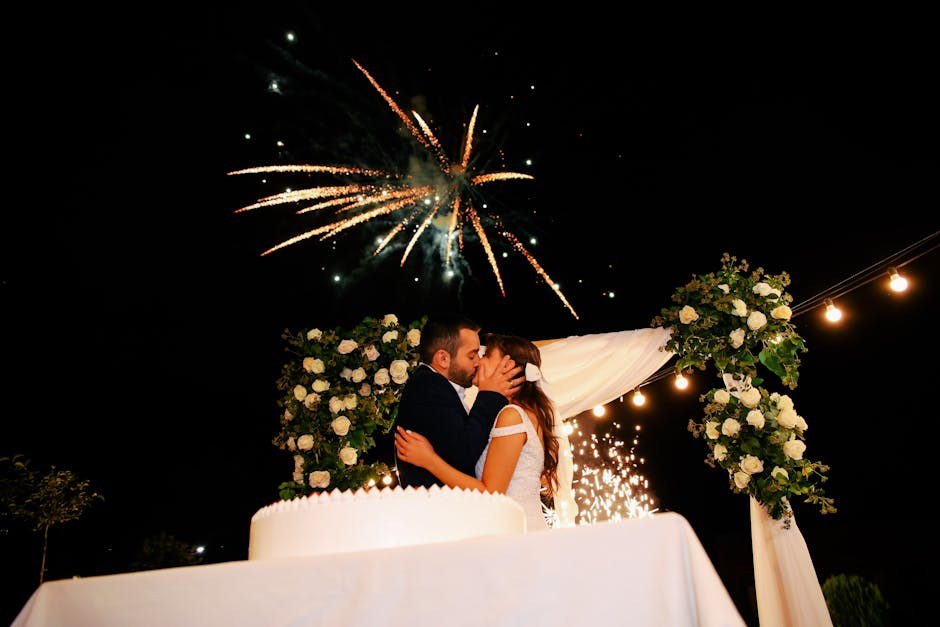There’s a moment when daydreaming about marriage slips from harmless curiosity into something louder – a hum in the background that follows you from brunch chatter to late-night scrolling. That hum has a name: wedding fever. It can hit whether you’re single, newly dating, or already in a committed partnership, and it often arrives just as your social feeds begin to fill with proposal clips, rings sparkling in soft focus, and carefully staged photos of the first kiss. When wedding fever shows up, it doesn’t ask for permission; it floods your imagination with color palettes, seating charts, and soundtrack ideas for a celebration that may still be far off on the calendar. This guide unpacks how that feeling snowballs, how to recognize the patterns, and how to keep your balance so the celebration – someday – can be joyful rather than exhausting.
Most people don’t wake up one morning obsessed. Wedding fever builds gradually. You attend a few ceremonies and notice the peonies, the string lights, the dress that glides like water. You tuck away mental notes – then actual notes – and before long you’re comparing venues in your head during your commute. Maybe you and your partner have talked about a future together, or maybe you’re simply hopeful. Either way, the fantasies start to look suspiciously like plans. You catch yourself browsing vendors you can’t yet hire, or picking a song for a dance that hasn’t been scheduled. It’s understandable: a wedding promises a scene where love becomes visible, where community gathers, where personal style takes center stage. The pull is powerful, and wedding fever amplifies that pull until ordinary days feel like pre-production for a movie you’re directing.
There’s also a practical twist that keeps the loop spinning. Many of us think that planning early will save stress later – that more research, more mood boards, more lists will mean fewer surprises. In moderation, that’s reasonable. But when wedding fever takes the wheel, you can end up living in a not-yet world, where every detail is rehearsed, debated, and locked in long before there’s a proposal or a date. The result isn’t control; it’s pressure. The celebration begins to look less like a shared expression of love and more like an exam you must pass. Knowing the signs helps you step back and breathe before the dream hardens into a demand.

Clear indicators you’ve caught the bug
People experience wedding fever in different ways and at different intensities, yet the patterns below appear again and again. Spotting yourself in several of them is a strong hint that wedding fever is steering your thoughts.
You’re not engaged, but you’re scheduling time for “the conversation” with your partner – not about values or timing broadly, but about the specifics of a ceremony you’ve already imagined.
Reality shows about dress shopping draw you in like a magnet, and you find yourself tearing up – in delight or frustration – when a stranger says yes to a gown.

Glossy magazines or digital lookbooks have become reference manuals; you fold corners, save screenshots, and annotate pages with fabric notes and silhouette ideas.
A guest list already exists on your phone, complete with tentative seating clusters and contingency plans for plus-ones.
You’ve researched local planners and quietly created a shortlist with emails and phone numbers you “might need later.”

Every restaurant, gallery, or garden you visit is evaluated as a possible venue – you’re measuring sightlines as if you carry a tape measure in your mind.
Your mood boards are heavy on hairstyles, makeup references, and accessory options for the big day – and you tweak them like a hobby.
The bridal party has been chosen in your head – maid of honor, attendants, and even who gives the toast – long before any official announcement.
You’ve mapped out an engagement-photo concept, complete with locations and a photographer whose portfolio you can quote by heart.
The first-dance song is a lock. You’ve listened to it on repeat until you know the exact point where the lights should dim.
Cake tastings have “accidentally” happened – perhaps under the charming pretense of supporting a friend’s event research.
Lines for vows pop into your notes app at odd hours – little sentences that feel too precious to lose.
You’ve configured a custom ring design online, complete with a matching band, and saved the mock-ups in a secret folder.
Playlists and shortlists for live musicians or DJs are ready, including backup acts in case schedules shift.
You’re debating shower formats – brunch, tea, dinner – despite not having a date on the calendar.
Invitation suites fascinate you; you’ve contacted artists for quotes and compared papers by weight and finish.
Any depiction of a ceremony – film, show, or a two-minute reel – makes you cry helplessly, even when the scene is fictional.
You’ve coached your partner on how to approach your parents for their blessing, outlining timing and talking points.
Alteration nightmares wake you – hems uneven, zippers stuck – even though no dress is hanging in your closet.
Floral arrangements from past weddings live in your memory like a catalog; you can list what thrilled you and what you would absolutely skip.
You reached out to a preferred officiant “just to check availability,” half-joking about a calendar that fills years ahead.
Caterer menus are bookmarked; you can describe tasting notes and seasonal swaps as if you’ve already sat through consultations.
Registry plans are set – which stores make the cut and which don’t – organized by category and style.
Your DIY favors have prototypes, supply lists, and a timeline that starts the moment an engagement becomes official.
Browsing boutiques “for ideas” turned into slipping into a gown or two, just to see how the silhouettes feel under the lights.
If you recognize yourself in many of these, take it as useful feedback rather than a scolding. Wedding fever thrives on forward motion – the sense that if you just decide one more detail, the anxiety will quiet down. Yet the list rarely ends there; another decision appears, and another after that. Understanding the engine is the first step to releasing your grip.
Why the chase for perfect takes over
From childhood onward, stories teach us that a wedding is not just special – it’s a pinnacle. When that narrative lives inside you, it feels natural to chase perfect. The venue should be cinematic, the menu elevated, the flowers lush, the wardrobe impeccable. The couple – and everyone standing beside them – need to appear as if they’ve stepped from a film set. Wedding fever converts that cultural script into a daily to-do list, and suddenly each choice carries the weight of a once-in-a-lifetime performance.
The trouble is that perfection is a moving target. Choose a classic palette and you’ll discover a trend you adore the next day. Book a space and a friend’s photos will make another location glow with possibility. Wedding fever whispers that the right decision is out there if you work hard enough, but the whisper never ends. Ironically, the pressure can drain the experience of the very joy it’s meant to amplify. Instead of imagining the way your community will feel gathered around you, you’re comparing linen swatches under three kinds of light and wondering whether the napkins should be folded or tied. What began as inspiration becomes obligation – and that’s when stress takes the driver’s seat.
There’s also a financial echo. Even when you intend to keep things simple, scrolling through expertly staged images can set a bar that feels non-negotiable. Wedding fever reframes luxuries as necessities. The effect isn’t limited to budgets; it also affects time, energy, and relationships. Loved ones can become characters in your internal production, valued for how well they fit the storyboard. When you notice that shift, it’s a cue to reset expectations and return to the heart of the celebration.
How to steady yourself when the excitement runs hot
You don’t need to shut down your imagination to stay grounded. A few core reminders will keep wedding fever from running the show while preserving the fun of dreaming together.
Re-center on meaning. A ceremony is, first and last, a public promise. The purpose is love – not spectacle. If a choice begins to overshadow that purpose, change the lens. Ask how a decision reflects your shared values rather than how it will photograph. Wedding fever loves optics; meaning quiets the noise.
Live in the chapter you’re in. It’s healthy to discuss the future, but your relationship also deserves your full attention today. Enjoy the weekend walks, the inside jokes, the ordinary dinners. Dream together in broad strokes and let the specifics wait. Wedding fever insists the future is urgent – remind yourself that intimacy grows in the present.
Release the need to micromanage. Tiny choices will not decide the quality of your union. Will anyone truly care whether the florals lean powder blue rather than teal? Probably not. If someone does, that’s about them, not you. Save your bandwidth for moments that foster connection. Wedding fever tells you to fix every variable; wisdom tells you to pick your battles.
These principles aren’t rules to follow; they’re anchors to keep you steady. When you feel yourself spiraling – another tab open, another spreadsheet made – pause. Ask whether you’re moving from inspiration or from fear. Inspiration opens your chest; fear tightens your jaw. If it’s the latter, step away and return when your shoulders drop.
Practical ways to keep perspective without losing the fun
Because wedding fever feeds on constant input, managing your intake helps. Create small habits that nudge you toward balance. For example, set boundaries around how often you browse galleries and vendor sites – perhaps a weekly window instead of an every-evening ritual. Keep a single document for ideas rather than scattering them across apps; this limits the sense of infinite research and reduces duplicate decisions. When the urge to plan strikes, funnel it into healthy conversations: talk values, atmosphere, and guest experience rather than specific brand names or price tiers you can’t commit to yet.
It also helps to address logistics honestly. If you and your partner expect to fund a celebration yourselves, acknowledge that openly and decide together what a comfortable spending range might look like someday. This isn’t about locking in numbers; it’s about aligning expectations so wedding fever doesn’t promise things your reality can’t support. Remember, constraint can be creative. Many of the most heartfelt celebrations are simple – full of intention rather than excess.
Finally, treat your inner planner with kindness. The part of you swept up in wedding fever is trying to secure joy. Thank that part, then remind it that joy isn’t purchased with more and more control. Joy appears when you are present – with your partner, with your friends, with yourself. The best rehearsal for a future ceremony is to practice presence now.
Bringing it back to heart
Zoom out for a moment. What makes a wedding moving is not the flawless timeline or the perfect shade of ribbon – it’s the sight of two people choosing one another in front of their community. The details can enhance that moment, but they cannot create it. Wedding fever often tricks us into believing the opposite: that if we curate hard enough, the meaning will appear. In truth, meaning is already there, quiet and sturdy. Your task is to make room for it.
So if you’re deep in the swirl – guest lists saved, playlists queued, bouquets ranked – take a breath. Smile at your imagination. Let your plans soften around the edges. Keep the dream, but hold it lightly.Let love lead and let your future unfold at a human pace. When it’s time to step into the lights, you’ll be ready – not because every detail is flawless, but because you stayed present to what matters most all along.
And if your story includes a season of waiting, use it well. Build the relationship you want to celebrate. Share meals. Learn new ways to communicate. Apologize quickly. Laugh often. Those are the real foundations – thicker than cardstock, sturdier than centerpieces, bright long after the candles dim. When the day arrives, you won’t just be staging a scene; you’ll be honoring a life you’ve already begun to live together. That is the quiet cure for wedding fever – returning, again and again, to love.